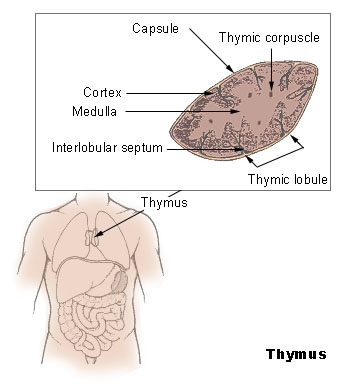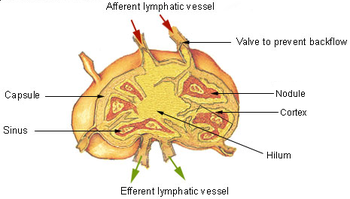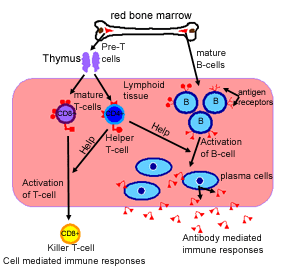What is it?
The immune system is a network of cells, tissues, and organs that work together to protect the body from infection. The human body provides an ideal environment for many microbes, such as viruses, bacteria, fungi, and parasites, and the immune system prevents and limits their entry and growth to maintain optimal health. Currently in research, scientists continue to study how the body targets invading microbes, infected cells, and tumors while ignoring healthy tissues. New technologies for identifying individual immune cells help scientists determine which cells trigger an immune response under various circumstances. Improvements in microscopy also allow for observations of living immune cells as they interact within lymph nodes and other body tissues. Furthermore, scientists have been rapidly unraveling the genetic blueprints that direct the human immune response. This new technology and expanded genetic information promises to reveal more about how the body protects itself from disease. In turn, scientists can use this information to develop new strategies for the prevention and treatment of infectious and immune-mediated diseases.
How does it work?
- The immune system is designed to defend you against millions of bacteria, microbes, viruses, toxins and parasites.
- An example of being able to see the immune system is when you get a cut, bacteria and viruses are able to enter your body through the break in the skin. The immune system responds and eliminates the invaders while the skin heals itself and seals the puncture. In rare cases the immune system misses something and the cut gets infected. It gets inflamed and will often fill with pus. Inflammation and pus are both side-effects of the immune system doing its job.
- There are many ways that you can get sick: for example, mechanical damage when you break a bone or tear a ligament, vitamin or mineral deficiency, organ degradation when an organ is damaged or weakened, genetic disease caused by a coding error in the DNA, and cancer, where a cell will change in a way that causes it to reproduce uncontrollably.
- In comparison, when a virus or bacteria invades your body and reproduces, it generates side effects by its presence we understand as symptoms. Strep throat bacteria releases a toxin that causes inflammation in your throat for example. Viruses and bacterial infections are the most common causes of illness for most people, causing things like colds, influenza, measles, mumps, malaria, AIDS and so on.
- The job of your immune system is to protect your body from these infections. It protects it through creating a barrier that prevents bacteria and viruses from entering your body, if it does get through this barrier, the immune system tries to detect and eliminate it before it can reproduce. If the virus or bacteria is able to reproduce, your immune system can then eliminate it.
- The skin acts as a primary boundary between bacteria and viruses and your body; it acts as a barrier as the skin is tough and generally impermeable to bacteria and viruses. The epidermis of the skin contains cells called Langerhans cells which are an important early-warning component in the immune system. The skin also secretes antibacterial substances, causing bacteria and spores that land on your skin to die quickly.
- Your nose, mouth and eyes contain an enzyme called lysozyme, which break down the cell wall of many bacteria. Saliva is also anti-bacterial. The nasal passage and lungs are coated in mucus, causing bacteria to be trapped in the mucus and swallowed. Mast cells also line the nasal passages, throat, lungs and skin. Any bacteria or virus that wants to gain entry to your body must first make it past these defenses.
- Inside the body, the major components of the immune system are: the thymus, spleen, lymph system, bone marrow, white blood cells, antibodies, complement system and hormones.
- The thymus: it is situated in your chest between your breast bone and your heart. It produces T-cells and is especially important in newborn babies - without a thymus a baby's immune system collapses and the baby will die.

- The spleen: it filters the blood looking for foreign cells
- The lymphatic system: it works by the fluids which ooze into the lymph system get pushed by normal body and muscle motion to the lymph nodes. Lymph is a clearish liquid that bathes the cells with water and nutrient, and also has blood plasma, the liquid which makes up blood without the red and white cells. Blood transfers these materials to the lymph through the capillary walls, and lymph carries it to the cells. The cells also produce proteins and waste products and the lymph absorbs these products and carries them away. Once lymph has been filtered through the lymph nodes, it re-enters the bloodstream.

- Bone marrow: it produces new blood cells, both red and white. Red blood cells are fully formed in the marrow and then enter the bloodstream. For some white blood cells, the cells mature elsewhere. The marrow produces all blood cells from stem cells which can branch off and become many different types of cells. Stem cells change into actual, specific types of white blood cells.

- White blood cells: white blood cells can ingest pathogens and destroy them, produce antibodies to destroy pathogens and produce antitoxins that neutralise that toxins released by pathogens. They can be grouped as phagocytes or macrophages and lymphocytes. Phagocytes can easily pass through blood vessel walls into the surrounding tissue and move towards pathogens or toxine. They then either ingest and absorb the pathogens or toxins or release an enzyme to destroy them. Having absorbed a pathogen, the phagocytes may also send out chemical messages that help nearby lymphocytes to identify the type of antibody needed to neutralise them. In comparison, lymphocytes work based on the fact that pathogens contain certain chemicals that are foreign to the body and are called antigens. Each lymphocyte carries a specific type of antibody - a protein that has a chemical 'fit' to a certain antigen. When a lymphocyte with the appropriate antibody meets the antigen, the lymphocyte reproduces quickly, and makes many copies of the antibody that neutralises the pathogen. Antibodies neutralise pathogens by binding to pathogens and damage or destroy them, coating coat pathogens, clumping them together so that they are easily ingested by phagocytes and they bind to the pathogens and release chemical signals to attract more phagocytes. Lymphocytes may also release antitoxins that stick to the appropriate toxin and stop it damaging the body.
- White blood cells are a whole collection of different cells that work together to destroy bacteria and viruses. Here are all of the different types, names and classifications of white blood cells working inside your body right now: Leukocytes, Lymphocyte, Monocytes, Granulocytes, B-cells, Plasma cells, T-cells, Helper T-cells, Killer T-cells, Suppressor T-cells, Natural killer cells, Neutrophils, Eosinophils, Basophils, Phagocytes and Macrophages
- All white blood cells are known officially as leukocytes and are divided in three classes: Granulocytes which make up 50 - 60% of all leukocytes, Lymphocytes which make up 30 - 40% of all leukocytes. Lymphocytes come in two classes: B cells (those that mature in bone marrow) and T cells (those that mature in the thymus). Monocyes make up 7% or so of all leukocytes which evolve into macrophages.
- All white blood cells start in bone marrow as stem cells which later will divide and differentiate into all different types of white blood cells.
- Neutrophils, the most common form of white blood cells, work by being attracted to foreign material, inflammation and bacteria. It will be attracted by a process called chemotaxis, allowing motile cells move toward higher concentrations of a chemical. Once a neutrophil finds a foreign particle or a bacteria it will engulf it, releasing enzymes, hydrogen peroxide and other chemicals from its granules to kill the bacteria.
- Eosinophils are focused on parasites in the skin and the lungs, while Basophils carry histamine along with mast cells to causing inflammation. It brings in more blood and it dilates capillary walls so that more immune system cells can get to the site of infection.
- Macrophages are the biggest cells, released by the bone marrow, float in the bloodstream, enter tissue and turn into macrophages. Most boundary tissue has its own devoted macrophages. They are called langerhans cells when they live in the skin.
- The lymphocytes handle most of the bacterial and viral infections. They start in the bone marrow. B cells develop in the bone marrow before entering the bloodstream while T cells starts in the marrow but then migrate through the bloodstream to the thymus and mature there. T cells and B cells are often found in the bloodstream but tend to concentrate in lymph tissue such as the lymph nodes, the thymus and the spleen. There is also quite a bit of lymph tissue in the digestive system. B cells and T cells have different functions.

- B cells mature into plasma cells which produce antibodies. A specific B cell is tuned to a specific pathogen, and when the pathogen is present in the body, the B cell will then clone itself and produce millions of antibodies designed to eliminate the pathogen.
- T cells will bump up against cells and kill them. They are known as Killer T cells which can detect cells in your body that are harboring viruses, and when it detects such a cell, it kills it. Two other types of T cells, known as Helper and Suppressor T cells, help sensitize killer T cells and control the immune response.

Thanks for reading!
No comments:
Post a Comment